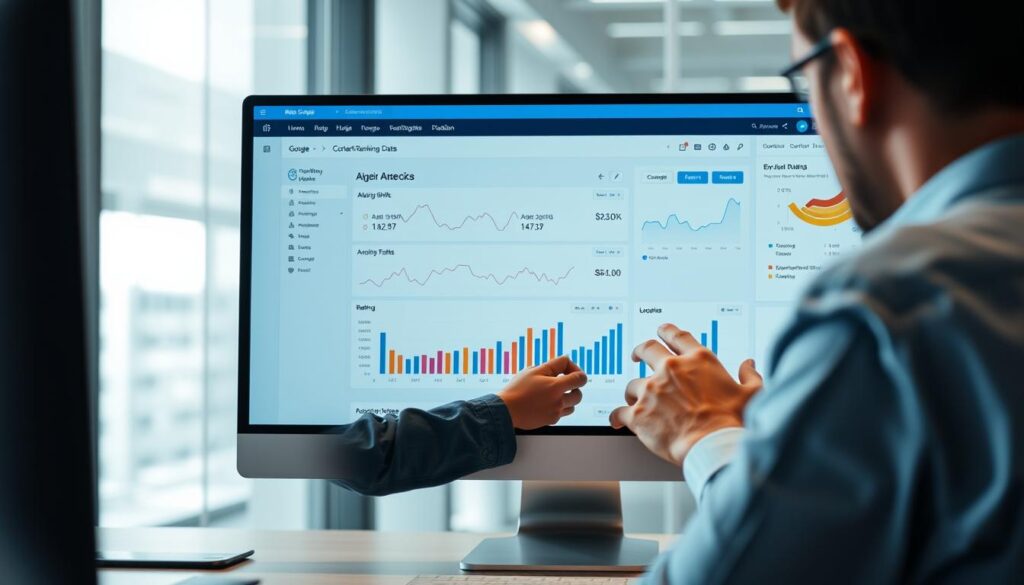Google shipped 4,781 changes in 2023, and a handful of major updates can reshape visibility overnight. This volatility is high-stakes for premium brands, but fast, disciplined teams convert disruption into durable advantage.
We bring boardroom-grade frameworks—WebberXSuite™ and A.C.E.S.—and case-led insights that turn turbulence into measurable growth. Our approach centers on original content that proves real experience, expertise, and trust at scale.
When core updates reduce low-quality results by nearly half, prepared websites climb while shortcuts fall away. We promise actionable, data-backed guidance: fast diagnostics, content upgrades, consolidation, and UX fixes that lift long-term performance.
We design growth systems for high-ticket enterprises. Expect a clear path to conversion—our Growth Blueprint and consultation model—to deploy an operating system that secures demand, not vanity metrics.
Key Takeaways
- Major updates shift rankings; disciplined content systems capture lasting gains.
- Proprietary frameworks guide audit, fixes, and scalable deployment.
- Original, experience-led content protects value across updates.
- Fast diagnostics and governance reduce risk and raise performance.
- We offer a Growth Blueprint and consultation to operationalize results.
The new reality: volatile updates, stable ROI—if you evolve fast
Revenue can evaporate overnight when rankings swing. We design a clear path from volatility to predictable growth by combining rapid iteration, governance, and data-led decision making.
Major update windows now recur several times a year. March 2024 ran 45 days and removed vast volumes of low-quality pages. August, November, and December 2024, plus March and June 2025 and an August 2025 spam update, proved the pattern: transient turbulence followed by durable winners.
Our approach treats updates as opportunity. We run tight cadences across content, technical, and link workflows so websites recover faster and compound advantage.
- Operational excellence: governance and playbooks that trigger triage and re-crawl when thresholds breach.
- Business-first metrics: dashboards that map rankings to qualified pipeline, not vanity numbers.
- Compound advantage: iterative upgrades widen the gap against legacy competitors.
| Focus | Immediate Action | Expected Outcome |
|---|---|---|
| Content governance | Audit, upgrade, consolidate | Faster recovery; higher rankings |
| Technical cadence | Prioritize CWV and crawl fixes | Improved website performance |
| Measurement | Pipeline‑linked dashboards | Stable ROI, decisive resource shifts |
What Google’s algorithm updates are and why they matter now
When ranking systems reweight relevance, leaders must move from reactive edits to systematic upgrades.
We define algorithm updates as platform recalibrations that refine how a search engine retrieves and ranks information. These updates aim to improve relevance, quality, and user experience. Executives see volatility because rollouts change signal weightings across millions of queries.
How ranking evolved:
- Panda (2011): targeted thin and duplicate content.
- Penguin (2012): penalized manipulative link tactics.
- Hummingbird → RankBrain → BERT: semantic and machine learning steps (2013–2019).
- Helpful Content (2022): prioritized people-first content.

The March 2024 core update (Mar 5–Apr 19; completion Apr 26) reduced low-quality content visibility by ~45%. 2024–2025 saw multiple core and spam actions, Site Reputation Abuse enforcement, and AI Overviews (May 14, 2024) using Gemini—each shifted how users receive answers.
| System | Primary Signal | Business Impact |
|---|---|---|
| Panda | Content quality | Prune thin pages; consolidate topics |
| Penguin | Link integrity | Audit backlinks; remove manipulative links |
| BERT / RankBrain | Semantic relevance | Optimize for intent and context |
| Helpful Content / Core Updates | User-first signals | Invest in original experience-led content |
Algorithm Changes & SEO: aligning strategy with user intent and quality
Search systems now favor demonstrable expertise, clear sourcing, and user-first content. We translate update signals into decision criteria that guide every content choice.
Core updates prioritize usefulness, credibility, and context. Focus on people‑first pages, expert bylines, and transparent citations. These elements turn ordinary pages into durable assets that serve user intent and lift rankings.
Core updates prioritize usefulness, credibility, and context
Decision rule: create assets that answer intent comprehensively and cite reputable sources. Consistent author credentials and original insight are non‑negotiable.
Spam and site reputation abuse: why shortcuts now get neutralized
Spam systems target cloaking, deceptive redirects, and parasite SEO. Manual actions and algorithmic enforcement since mid‑2024 mean shortcuts now carry real risk.
- Build authority with high‑quality backlinks from relevant outlets.
- Institutionalize E‑E‑A‑T governance: bylines, reviews, and evidence.
- Prioritize usefulness and brand demand to withstand future update cycles.
| Signal | Priority Action | Outcome |
|---|---|---|
| Usefulness / intent | Expand topical depth; add expert input | Higher relevance in search results |
| Credibility / E‑E‑A‑T | Show bylines; source evidence | Stronger trust and brand searches |
| Site reputation / spam | Remove parasite pages; fix redirects | Reduced risk of manual penalties |
Spot the impact: how to diagnose ranking shifts post‑update
A precise diagnostic cuts recovery time and tells you where to deploy resources first. We run a short cadence that separates rollout noise from persistent loss.

Reading SERP volatility versus lasting changes
Track volatility during the rollout window and pause structural edits until the update completes. Short-term swings often normalize; lasting drops need treatment.
Sitewide versus page‑level signals to check first
- Compare windows in Google Search Console: clicks, impressions, CTR, and average position by page.
- Inspect site health: coverage, sitemaps, Core Web Vitals, crawl anomalies, and indexation.
- Audit page factors: intent match, content depth, freshness, internal links, schema, and on‑page structure.
Action cadence: triage (48–72 hrs), remediate (1–4 weeks), re‑crawl and monitor (4–12 weeks). Log every step in an update journal so playbooks improve over time.
Build brand and E‑E‑A‑T moats that resist core updates
Resilient brands win when they turn original experience into public, verifiable assets.
Demonstrate experience and authority with original insights. Publish proprietary studies, benchmarks, and methodologies that only your team can produce. Add author bios with verifiable credentials and link to primary sources. First‑hand evidence beats boilerplate summaries every time.
Strengthen trust with high‑quality backlinks and branded demand. Earn links through thought leadership, research, and partnerships—not link schemes. Promote branded search via PR and repeat engagement to create durable signals that help rankings through updates.
YMYL caution: when credentials and accuracy are non‑negotiable. For medical, legal, or financial content enforce peer review, clear bylines, and strict fact checks. Protect users and your brand by documenting review dates and sources.
- Turn expertise into assets: original data and repeatable frameworks.
- Credential authors: visible bios and verifiable experience.
- Amplify brand demand: PR, thought leadership, and branded queries.
- Earn high‑quality backlinks through genuine research and partnerships.
- Instrument trust: policies, citations, and transparent updates across pages.
Design for users: UX and technical SEO that survive every update
Performance and clarity decide long-term value. We focus on measurable user experience improvements that protect traffic during update windows and lift conversion velocity.
Core Web Vitals and mobile-first: speed, stability, and interactivity
We prioritize Core Web Vitals: improve LCP, INP, and CLS through image optimization, script deferral, and stable layout patterns.
Action: run lab and field tests, set performance budgets, and treat regressions as incidents that block releases.
Navigation, ad experience, and content layout that reduce friction
Clear navigation and logical headings reduce friction for users and search engine crawlers. Above‑the‑fold value must appear instantly.
Monetization: limit disruptive ads and preserve reading flow to protect trust and perceived quality.
Media optimization: WebP, compression, and performance budgets
Adopt WebP, compress assets, and lazy‑load below‑the‑fold media. This keeps visuals rich without harming site speed.
Institutionalize QA and regression checks on templates so performance debt does not reappear.
- Improve LCP by optimizing hero images and server response times.
- Cut INP via script deferral and smaller interaction bundles.
- Fix CLS with reserved image sizes and stable ad slots.
| Priority | Immediate Tactic | Business Outcome |
|---|---|---|
| Core Web Vitals | Image formats, CDN, defer scripts | Faster pages; better user experience |
| Mobile‑first | Responsive components; accessible tap targets | Higher engagement from on‑the‑go users |
| Media & monetization | WebP, compression, limit disruptive ads | Preserved trust and higher conversion rates |
Content that wins: how to update, consolidate, and internally link
A disciplined content program turns scattered pages into authoritative hubs that command visibility. We inventory coverage, flag thin or duplicative assets, and rank them by intent and business value. Prioritize the pages that move conversion and traffic during update windows.
Upgrade thin or outdated pages; prune truly unhelpful content
We upgrade where subject‑matter depth and user experience align with goals. When a page cannot be salvaged, we prune it, issue a redirect, and consolidate its signals into a stronger hub.
Topical depth and clusters: connect related assets with descriptive anchors
Architect pillar-cluster models to show topical breadth. Use descriptive, intent‑rich anchors so links pass clear context and help search discover related pages.
- Inventory: map gaps and duplicates.
- Consolidate: merge overlapping pages into pillars.
- Standardize anchors: use descriptive phrases, not generic text.
- Redirect equity: link from high‑authority pages to strategic targets.
- Document: log updates, redirects, and internal linking for measurement.
Keyword strategy in the era of semantic search and AI Overviews
Keyword strategy must now map intent and conversational context, not just surface matches. We design content to answer related queries across the entire journey. This shifts focus from single keywords to clusters of long‑tail and contextual terms.
From exact matches to intent coverage: long‑tail and contextual terms
Map user intents and group long‑tail phrases by stage: awareness, evaluation, and conversion. Use entity-rich headings and examples that show real experience.
Practical tactic: prioritize pages that capture multiple query types so a single hub can win diverse results.
Structuring answers for AI Overviews and rich results
AI Overviews favor concise summaries, lists, and clear data. Format with short lead paragraphs, bullet lists, and structured tables to increase eligibility for featured snippets and rich results.
Provide a succinct answer first; follow with evidence, examples, and a short FAQ to capture attention and clicks.
- Schema: add FAQ, HowTo, and Product where relevant.
- Information gain: include unique data, examples, and citations.
- Measure: track how AI Overviews affect click rates and adjust layouts.
| Element | Format | Benefit |
|---|---|---|
| Concise summary | 1–2 sentences at top | Higher chance for AI Overviews and featured results |
| Lists & tables | Bullet points, comparison tables | Improved scanability and rich snippet eligibility |
| FAQ + schema | Structured Q&A with markup | Broader SERP surface and voice assistant coverage |
Stay compliant: avoid black‑hat tactics and site reputation abuse
Compliance is a competitive advantage; it preserves brand equity and future traffic. We forbid cloaking, deceptive redirects, keyword stuffing, and purchased links. These tactics deliver short gains and long‑term damage.
Google’s Site Reputation Abuse policy (enforced May 6, 2024) and recent spam updates aggressively demote parasite SEO and low‑quality content on trusted domains. Modern systems find shortcuts fast, and penalties erase earned trust.
We choose durable strategies: ethical authority building, rigorous editorial controls, and transparent partner vetting. Governance prevents risky articles and third‑party pages from entering your ecosystem.
- No cloaking or deceptive redirects.
- No buying links or link schemes.
- No keyword stuffing or low‑quality content.
| Non‑compliant | Compliant alternative | Business outcome |
|---|---|---|
| Cloaking / deceptive redirects | Clear redirects; truthful UX | Preserved brand trust; fewer manual actions |
| Parasite SEO on third‑party sites | Publish original research on owned website | Durable organic authority; branded demand |
| Buying links / link schemes | Earned partnerships and citations | Stable referral value; less volatility |
| Keyword stuffing / thin pages | Deep, user‑first content with citations | Better engagement and longer lifetime |
Your monitoring stack: tools, cadences, and recovery playbooks
Monitoring is the nervous system of resilient content programs. We build a unified stack that surfaces meaningful signals quickly so leaders can act with confidence and protect revenue.
Dashboards to track
- Google Search Console for performance and coverage metrics.
- Analytics for traffic, conversions, and pipeline attribution.
- PageSpeed Insights and Core Web Vitals for website performance and UX health.
- Rank trackers and crawl tools (Screaming Frog) for visibility, indexation, and technical issues.
Update watchlist
Maintain a live watchlist of core and spam update windows—March, August, November, and December 2024; March and June 2025 cores; August 2025 spam—so teams can contextualize drops and avoid knee‑jerk tactics.
Recovery timeline: triage, remediate, re‑crawl
We define a three‑step playbook. Triage stabilizes site health and fixes critical technical issues that block indexing.
Remediate high‑impact content: upgrade assets, consolidate cannibalized pages, and reinforce clusters with internal links and high‑quality backlinks.
Request re‑crawl and refresh sitemaps. Track logs and GSC reports until rankings and queries show recovery.
Tie every recovery action to executive metrics: lost revenue, qualified pipeline, and projected ROI. This keeps the program prioritized and funded.
| Phase | Primary Actions | Expected Outcome |
|---|---|---|
| Triage (48–72 hrs) | Stabilize crawlability; fix server errors | Reduced drop severity; clearer diagnosis |
| Remediate (1–4 weeks) | Content upgrades; consolidate pages; fix technical issues | Gradual restoration of rankings and traffic |
| Re‑crawl & Monitor (4–12 weeks) | Submit sitemaps; track GSC and rank visibility | Confirm recovery; measure ROI |
Operational rules: centralize alerts, assign clear owners, and predefine thresholds for automatic escalations. We tie dashboards to revenue so every remediation maps to business impact.
Conclusion
Sustained performance comes from linking content quality to clear operational playbooks.
Embed E‑E‑A‑T, governance, and UX discipline so your site weathers major algorithm updates and recovers faster. Recovery from core shifts can take months to a year, so timing matters.
We turn audit, prioritization, and rapid deployment into a repeatable system that fixes issues, raises quality, and improves search performance.
Act now: explore Macro Webber’s Growth Blueprint and book a strategy consultation. Limited onboarding slots each quarter preserve partner focus—secure your slot before competitors do and convert updates into lasting results.



